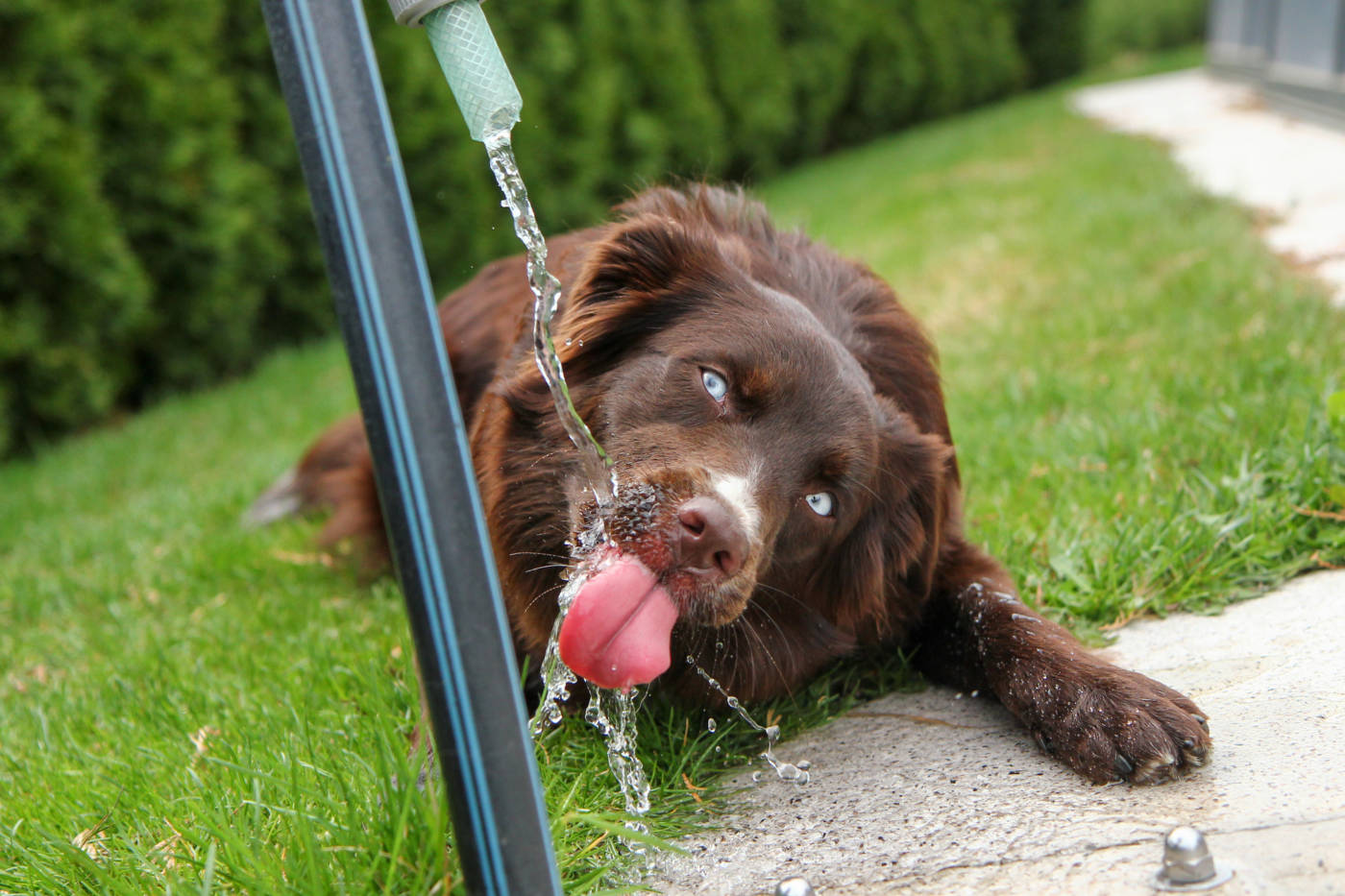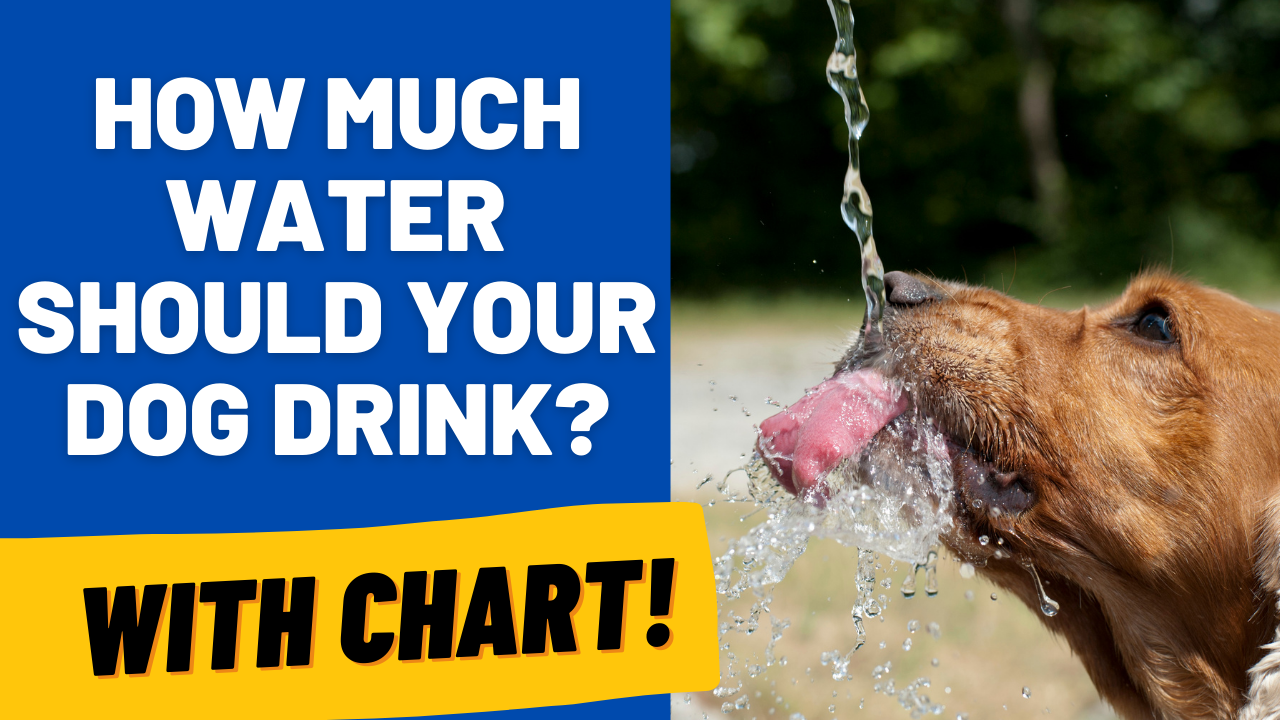Knowing how much water your dog needs to stay healthy is essential for their health and well-being. Of course, as a dog owner, you don’t want your pet to become dehydrated or sick. A dog’s body naturally depletes its water supply throughout the day as it performs various bodily functions. Because of this, they must replenish the fluid they lose. But, too much water can actually be deadly too. So, exactly how much water should a dog drink?
How Much Water Does a Dog Need in a 24-Hour Period?
Dogs should drink 0.85 – 1.75 ounces of water per pound of body weight daily. Or 50 to 100 ml of water per kg using the metric system. Therefore, a 10-pound dog should drink between 8.5 and 17.5 ounces per day. While a 10 kg dog should consume between 500 ml and 1 full liter a day.
You can use this dog water intake calculation chart for conversions:
To know whether they need water more water, it’s essential to take into account various factors:

Temperature and exercise
When it’s hot or humid, dogs need to drink more because they lose the fluid in their bodies faster, mainly through panting.
This is also true if they are exercising or being extremely active. Short-nosed (brachycephalic) breeds like pugs or bulldogs also struggle to cool down effectively and may need more water.
Medical issues and medicines
Certain conditions and medical issues, such as diarrhea, vomiting, and incontinence, will cause dogs to require more moisture than usual. During this time, their bodies lose a lot more fluid. Unless they are constantly drinking water and electrolytes to replace the lost fluid, they risk becoming dehydrated.
Dogs with renal, kidney, and liver issues, in particular, need more water and typically require a high-moisture diet. This can be wet food or appropriate dry food with a cup of water added to it.
Certain medications can also cause excessive thirst.
The type of food your dog eats
In general, take into consideration the meals that your dog is consuming. For example, if they eat dishes with plenty of moisture, the fluid from their meals could count toward their water intake.
Dogs on dry food should drink more water to keep their kidneys and renal tract functioning optimally.
Age of your dog
Puppies and senior dogs aren’t as good at regulating their own water intake. So it’s a good idea to keep an eye on their drinking habits.
The Fitbark Activity Monitor and Whistle GO actually track behaviors such as how often your dog drinks water. This can alert you if there is a drop in frequency and your dog may not be taking in enough fluids.
Likewise, it can also tell you if your dog starts drinking much more water, indicating health issues.
Dog Water Intake Calculator
Here’s a water intake calculator you can use to help you figure out how much water your dog needs. Remember that these numbers are approximate, and there can be mitigating factors for how much water your dog should get. See the above for the various factors.
You might also be interested in reading, When Is It Too Hot to Walk a Dog?
Veterinarian Comment
If you are unsure how much water your pet is consuming in a day, you can try to measure it out. This is easily accomplished in a single animal household but may be more cumbersome in households with multiple pets as they may need to be separated for monitoring water intake.
At the beginning of the day measure out how much water you place in their bowl. As the day continues, record any amount you add to their bowl. In the morning, measure out what is left. This is a ROUGH estimate, but it can be a great starting point!
Dr Marti Dudley
Can Dogs Drink Too Much in One Sitting?
Dogs can over-hydrate themselves if they drink too much water. Sometimes, a tired, hot, and dehydrated dog may simply drink so much water in one go that it causes them to vomit. This can make dehydration worse. Always allow your dog to drink a small bowl of water after or during an activity.
Wait about 10 minutes before giving them more. Aim to rehydrate them gradually.
In addition, dogs with medical conditions like diabetes or who are on certain medications are also prone to excessive drinking.
While giving your dog plenty of water to drink to avoid dehydration is important, giving your dog too much water can be harmful. Excessive water consumption can even be fatal. This condition is known as hyperhydration, water toxemia, or water intoxication.
Seizures, brain damage, coma, and even death are possible outcomes in severe cases.
Why Is My Dog Always Thirsty?
Dogs that are constantly thirsty are often simply active in hot climates. High-intensity physical activity causes them to deplete their bodily fluids more quickly. As a result, they are always thirsty.
Some dogs are just obsessed with water and we have a post on that here.
Certain medical conditions in dogs cause excessive thirst or polydipsia. For example, a dog suffering from pancreatitis will exhibit signs of being constantly thirsty, while dogs with diabetes urinate so frequently that they consume much more water.
Sometimes a dog is expelling a significant amount of fluid through vomiting and diarrhea due to their medical condition, which may cause them to drink more. Although in many cases, a sick dog might refuse water and risks dehydration.
Other medical conditions that can cause polydipsia include:
- Cushing’s disease
- Cancer
- Diarrhea
- Kidney and liver disease
- Fever
- Thyroid issues
- Infections
It’s also possible that dogs are constantly thirsty because they’re taking medication that causes them to feel dehydrated. This condition could be a side effect of the drug. Prednisone is one example that can make dogs excessively thirsty.

How to Check for Dehydration
It is relatively simple to detect dehydration in dogs. One of the first things you can do to determine whether or not your dog is dehydrated is to look inside their mouth. If you feel that your dog’s gums are sticky and their tongue is dry, this is usually one of the first signs of dehydration.
A good test is the capillary refill time, which you can also spot in the gums. This is the time it takes the blood supply to the mucous membranes to restore itself. By pressing your finger against the gum, you block the blood flow, resulting in the appearance of a white spot.
As soon as you remove your finger, the white spot should quickly turn pink again. If it turns pink within 2 seconds, your dog is hydrated. 2 to 3 seconds indicates some dehydration. But suppose it is delayed for more than 4 or 5 seconds. In that case, the dog may be suffering from severe dehydration and might need medical treatment.
The signs of dehydration will also be visible on their skin in some cases. If you examine a dehydrated dog’s skin, you might notice that it has lost elasticity. The skin around the neck, forehead, and shoulders may take a long time to return to its original position if you gently pinch or pull it in these areas with your fingers.
Tenting is another term used to describe this condition. It is also one of the most straightforward methods of determining dehydration.
What to Do if Your Dog or Puppy Isn’t Drinking Enough
If you want to help and encourage your dog to drink more water, place water bowls all over the house so that they have easy access to them. You can also give them food that is high in water content like canned dog food. Try offering an unsalted chicken or bone broth in place of water if they still aren’t interested or add water to their food.
Be careful of adding salt to dog food, as too much can be toxic, and dogs with heart issues need very low-sodium diets.
A severely dehydrated dog needs to see a vet immediately and probably needs a drip. Don’t allow them to drink too much at once.
Veterinarian Comment
If your pet is significantly dehydrated, they may need hospitalization. When this occurs, an intravenous catheter is placed, and fluid is administered directly into the vein. There are several different types of fluids available, and your veterinarian will pick a solution based on your patient’s condition. Some animals may require subcutaneous fluid administration which is when fluid is delivered underneath the skin, and slowly absorbed overtime.
Dr Marti Dudley
You can also offer ice cubes to your dog if you are concerned about their temperature being too high. Never place water or ice cubes in the mouth of a dog who is not alert or aware. Always keep in mind that heatstroke is deadly, and if you suspect your dog has it, treat it like a medical emergency.
To avoid dehydration-related problems, you should always supply your dog with plenty of fresh water. After a strenuous workout, try to keep your dog from guzzling down too much water at one time. You should never let your dog down a whole bowl of water in one setting. Instead, interrupt your pet, and then allow your dog to go back to the bowl in a few minutes. If a large quantity of water is consumed in one setting, regurgitation or vomiting may occur.
Watch out for any changes in your dog’s habits, such as drinking more than usual or less, as both could be signs of health problems.
How to Check for Water Intoxication
In the event of water intoxication, it is up to you as a dog owner to recognize the symptoms and how to respond until help arrives. Learn about water toxicity, and you may one day save your faithful companion’s life.
Water intoxication manifests differently depending on the dog’s size, health status, and how long it’s been since they’ve ingested it. Vomiting, dilated pupils, glazed eyes, restlessness, pale gums, lethargy, loss of coordination, and bloating are just a few warning signs to watch.
The most common causes of water toxemia are participating in activities such as swimming or dock diving and swallowing too much water. A dog chasing water from a hosepipe or sprayer is also at risk. And, naturally, a dog with a medical condition could drink too much water.
A severe case could cause a dog’s nervous system to shut down within hours, posing a life-threatening issue due to dog brain swelling. Fortunately, there is a good chance of a positive outcome with prompt medical attention.
Speaking of water, you might be interested in reading our post, My Dog Won’t Swim: Should I Be Worried?
What To Do If Your Dog or Puppy Drank Too Much
If your puppy drinks too much in one go and vomits, they may have drunk too much at once and need to gradually take fluid in. But if they struggle to hold water down, it is a sure sign they are sick.
In some cases, thyroid or kidney issues could cause excessive drinking and put a dog at risk of water toxemia.
If your pup has been swimming or chasing a sprayer and ingested too much water, they may lose some coordination if it is a mild case but recover quickly. However, if you notice any other symptoms, your dog needs to go to the vet as soon as possible.
Your vet will have to supply carefully replace the lost sodium and electrolytes and diuretics to flush out the excess water. Your dog may also need medication to prevent brain swelling and damage.
Should you let your puppy drink water at night?
Final thoughts
As with all things, keep in mind that both too little and too much of something are problematic. Hyperhydration is just as deadly to dogs as dehydration. It is vital to be aware of the symptoms for both and make sure your dog gets medical treatment if necessary.
But keeping a general eye on your dog’s drinking habits is also helpful. A dog that starts to drink less than usual, or more, could be a symptom of an underlying issue. Finally, knowing roughly how much water your dog should be drinking daily is a good step toward optimizing their health.
Are you interested in reading about this: Let Puppy Drink Water at Night: Yes, No, How Much?




